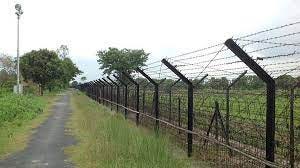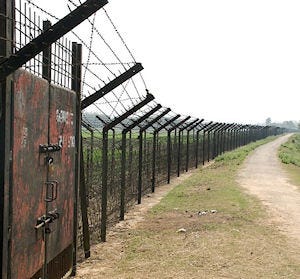Remembering Felani Khatun (Part I)
I heard about Felani Khatun a few months ago and ever since have not been able to let her slip out of my mind. Ten years ago, Felani Khatun, born in India to Bangladeshi parents, was shot dead by a Border Security Guard of India (BSF). She and her father were jumping the border fence to enter Bangladesh. The incident happened on 7th January 2011 on the fence at Dinhata, Cooch Behar, West Bengal. The guard who fired the shot was charged with murder and later acquitted by the BSF Court in India for want of evidence to impute knowledge or intention. The Kolkata High Court called the incident an unfortunate accident and Felani its victim. Felani, at the time of death was a minor, a fifteen-year-old girl, child labor in India. She and her father were crossing the border with the help of three smugglers for her to enter into child marriage in Bangladesh. When her clothes got entangled in the fence she started screaming and the BSF Guard opened fire. Her body remained on the fence for a few hours in the same condition before it was pulled down. The de-humanizing conditions of her death cannot ever be written off, instead ought to serve as a telling evidence of complex border issues that have outgrown the individuals it affects.
It was when I dug deeper into the incident, I found her story strewn in legal documents, NGO reports and news clippings. Each of them focused more on the incident and its aftermath rather than the peculiar conditions that led this girl to death. While the entire furor revolved around whether or not BSF should assume responsibility, the story of Felani Khatun seemed to be conspicuously absent. India responded by taking legal action against the Guard under domestic law while making no comment on cross border violence. The incident was officially viewed as a crime and placed de hors the socio-political contexts of surveillance policy, partition, migration, women`s rights and child labor. Felani`s defenselessness goes back to her birth as a woman which makes her a natural victim of patriarchal culture and practices. Her status as forced migrant adds another layer of destitution. Felani was admittedly a victim of child-labour, child-marriage and forced migration. I therefore believe that it is imperative to question her agency and extent of empowerment while understanding the facts that led to her death.
The experience of living in a heavily militarized area is often an experience of masculinization that affects the ways in which women may perceive their everyday reality and conversely also affects the ways in which women are perceived. In addition to the inherent horrors of a patriarchal society, to deal with structural power for negotiating everyday life can render women voice-less and defense-less. Such dominant constructions of power and masculinity drive the feminine existence into the unreachable and subvert gender identities even further into a point of invisibility much like Felani who is visible only in death. To imagine how Felani Khatun must have walked to the border that night with five men, to be married to a sixth man and ultimately experienced a violent death remains a deeply disturbing thought.
In addition to such pre-existing social complexities the militarized border has served as a validation of blanket ‘otherisation’ of Bangladeshi nationals and at worse as a symbol of jingoist national integrity. The socio-economic conditions of the border lands have been shaped by a history of dislocation and abandonment of its people. These conditions in turn interplay with constructs of gender, caste, class, sexuality and power. The narrations of the people if not given precedence, the particular stories of violence and suffering would cumulate in a statistical tables reducing the individuals to being ‘objective’ data for analysis.
In 2019 India has passed the Citizenship Amendment Act that confers citizenship on persons from six communities and three countries excluding the other migrants from its benefits. The Bill provides differential treatment to migrants on the basis of religion, country of origin, date of entry and place of residence in India. How these factors cannot be a reasonable purpose and test for differentiating between individuals is a separate subject for consideration. The impact of the amendment was huge. There were nationwide protests against the exclusion of the Muslim Community and the fear of prejudice and hate crimes. Further, India is not a party to the 1951 Convention on Refugees, it does not have any domestic law on refugees or asylum. While the persons charged under the relevant provisions are tried in Foreigner`s Tribunals and remain in Detention centers until deported while the rest, like Felani Khatun, are consumed in the underbelly of our economy.
The elephant in the room is no longer invisible.
As women stand to be twice as affected in any patriarchal society, even in cross border migration gender specific issues remain unseen. While we continue to deal with the issues of the borderlands, women`s stories and problems need to be incorporated into the decision-making process. Otherwise, we will continue to stare one dimensional realties and women as bodies to be transported and recovered. The memory of Felani Khatun, however painful, is a cry for resistance against super imposition of non-inclusive regimes that only add to another layer of violence if nothing else.
NOTES
1) The photographs of Felani Khatun are available on the internet. As the visual may be triggering it is not shared with this article.
2) The trial of Amiya Ghosh was conducted by BSF Court in Cooch Behar that acquitted him in 2013 on the ground that there is no evidence. Afterwards the Confirming Authority initiated administrative action against Amiya Ghosh. He challenged the show cause notice in Kolkata High Court which quashed it. The material information about the trial can be gathered from the Kolkata High Court Order which is freely available on internet.
3) The Indian law of citizenship is governed by Constitution of India (Part I) Article 5-11 & The Citizenships Act 1955 as amended by the Citizenship Amendment Act, 2019. The Foreigners Act, 1946 and The Passports Act, 1967 determine law and procedure pertaining to non-citizens in India.
REFERNCES
1) Pay Rs. 5 Lac for death of Bangladeshi Teen, By Shiv Sahay Singh published in The Hindu on 1st September 2015
2) Last Hope: Family of Dhaka girl shot by “India`s BSF” awaits justice from Supreme Court, by Ariful Islam, published in Dhaka Tribune; republished in https://scroll.in/ on 9th January 2019.
3) With SC to hear Petition killings at Bangladesh Border back in focus, by Rajashri Dasgupta published in https://thewire.in/ on 5th March 2020.



